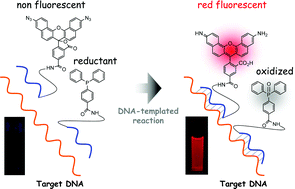Reduction-triggered red fluorescent probes for dual-color detection of oligonucleotide sequences†
Abstract
We have developed a new red fluorogenic compound derived from naphthorhodamine for a reduction-triggered fluorescence probe to sense

* Corresponding authors
a
Nano Medical Engineering Laboratory, Advance Science Institute, RIKEN, 2-1, Hirosawa, Wako-Shi, Saitama, Japan
E-mail:
h-abe@riken.jp, y-ito@riken.jp
b Molecular Characterization Team Advanced Technology Support Division, Advance Science Institute, RIKEN, 2-1, Hirosawa, Wako-Shi, Saitama, Japan
c Department of Life Science and Medical Bio-Science, Waseda University, 2-2 Wakamatsu-cho, Shinjuku-ku, Tokyo, Japan
We have developed a new red fluorogenic compound derived from naphthorhodamine for a reduction-triggered fluorescence probe to sense

 Please wait while we load your content...
Something went wrong. Try again?
Please wait while we load your content...
Something went wrong. Try again?
K. Furukawa, H. Abe, J. Wang, M. Uda, H. Koshino, S. Tsuneda and Y. Ito, Org. Biomol. Chem., 2009, 7, 671 DOI: 10.1039/B817228E
To request permission to reproduce material from this article, please go to the Copyright Clearance Center request page.
If you are an author contributing to an RSC publication, you do not need to request permission provided correct acknowledgement is given.
If you are the author of this article, you do not need to request permission to reproduce figures and diagrams provided correct acknowledgement is given. If you want to reproduce the whole article in a third-party publication (excluding your thesis/dissertation for which permission is not required) please go to the Copyright Clearance Center request page.
Read more about how to correctly acknowledge RSC content.
 Fetching data from CrossRef.
Fetching data from CrossRef.
This may take some time to load.
Loading related content
